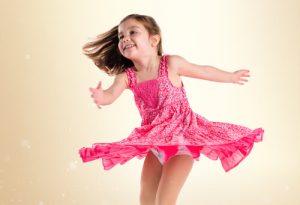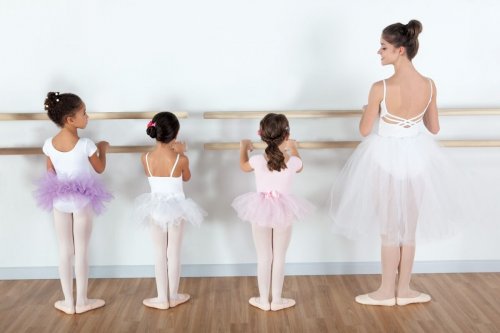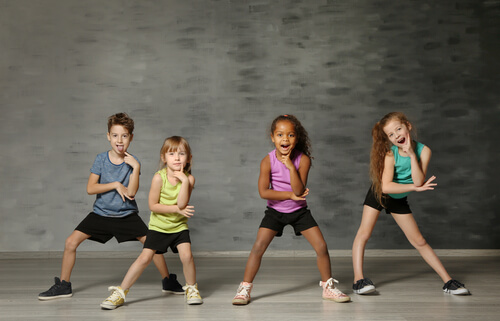Benefits of Dancing for Children

There are several benefits of dancing for children and adults alike. Dancing provides numerous psychological benefits. It’s not only a physical activity, but it’s also fun and social.
Most children love dancing. We often see babies dance after hearing their first few notes of music. Like so many things that occur during the development stage, dancing is a beneficial activity for children, both physically and psychologically. Dancing should be encouraged even before little ones start to take their first steps.
Benefits of dancing for children
You can encourage your child to dance from a young age. The musical style doesn’t matter; it’s simply important for them to listen to different rhythms.
In order to encourage dance, you can start off by dancing with your baby in your arms or even while the baby is in their carrier. This way the baby will enjoy dancing while accompanying the rhythm of the music.
“Dancing with your baby will improve your relationship with them. It will also provide many intimate and fun moments.”
As your children grow, you can dance with them by guiding their hand or by performing simple steps that they can imitate. This will help them acquire rhythm and a musical ear. Dancing can also improve coordination, balance and strength.

Practice dancing
When children start to grow, they start to enjoy dancing even more. We aren’t only referring to ballet; we’re also referring to other dance styles that are now common extracurricular activities.
Nowadays, there are new forms of modern dance emerging that combine the benefits of the disciple with fun.
“Modern dance includes various movements and energetic rhythms that children enjoy.”
Exercising to different rhythms including Zumba and break dancing has gained popularity over the last few years. These new styles of dance can have a positive impact on your child’s body and mind.
Benefits of dancing
- Physical exercise. Dancing is a complete exercise that requires the use of almost all the muscles in the body. Therefore, it can contribute to developing their physique and agility.
- Psycho–motor development. Moving to the rhythm of music isn’t as simple as it seems. This is even tougher if the child is trying to adapt to prepared choreography. Practicing dance will help improve their psychomotricity, coordination, balance and sense of rhythm.
- Fun. Most children enjoy dancing. They enjoy it even more when it is to the rhythm of a familiar song. Modern dance includes varied and energetic movements that they will enjoy.
- Creativity. Children are able to express their creativity through dance. They can also develop a musical ear and work on their memory.
- Teamwork. In both classical and modern dance, there are certain pieces that require dancing in pairs or in groups. This will help your child learn how to work as part of a team. It can also help improve their social skills.
- Self–esteem. Dancing can reduce the symptoms of stress and anxiety. It can also increase your child’s confidence in themselves, which in turn improves their self-esteem. Dance can help them overcome challenges such as shyness.

What is the best type of dance for your child?
As we previously stated, all types of dance can bring numerous benefits. Traditionally one of the best-known dance styles is ballet. Ballet can help instill the values of responsibility and discipline in your child. There are also new varieties of modern dance that are fun and full of energy.
Ideally you should let your children choose what kind of dance they would like to practice. They should be allowed to choose according to their musical preferences.
As parents it’s important for us to support our children’s decisions and to help instill in them the value of perseverance. We should also be able to inspire them to try new activities.
We should be the ones who accompany them as they discover new hobbies, friends and experiences.
All cited sources were thoroughly reviewed by our team to ensure their quality, reliability, currency, and validity. The bibliography of this article was considered reliable and of academic or scientific accuracy.
- Andreu, R. C., Torres, L. H., & Quiles, O. L. (2011). Las motivaciones de los niños para aprender música en la Escuela de Música y Danza de Melilla. Dedica. Revista de Educação e Humanidades, (1), 293-318. https://dialnet.unirioja.es/servlet/articulo?codigo=3625408
- Hallam, S. (2010). The power of music: Its impact on the intellectual, social and personal development of children and young people. International Journal of Music Education, 28, 3 (2010) 269-289.
- Hargreaves, D. J. (1991). Infancia y educación artística. Madrid: Morata.
- Moledo, C. P., & López, J. C. (2013). ¿ Podemos mejorar nuestra salud mental a través de la Danza?: una revisión sistemática. Retos. Nuevas tendencias en Educación Física, Deporte y Recreación, (24), 194-197. https://www.redalyc.org/pdf/3457/345732290038.pdf
- Padilla, C., & Zurdo, R. (2009). Desarrollo de la creatividad a través de la danza improvisación y la danza contacto. Valores y aplicaciones en Educación Primaria y Secundaria Expresión Corporal y educación. Sevilla: Wanceulen.
This text is provided for informational purposes only and does not replace consultation with a professional. If in doubt, consult your specialist.
